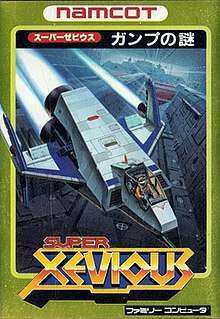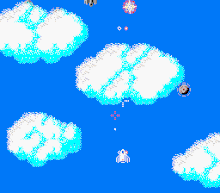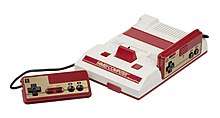Super Xevious: GAMP no Nazo
Super Xevious: GAMP no Nazo[lower-alpha 1] is a 1986 vertical-scrolling shooter video game developed and published by Namco for the Family Computer in Japan. It is the sequel to Xevious, a popular arcade game from 1983, and the fourth installment in the Xevious franchise overall. The player controls a spaceship named the Solvalou in its mission to destroy a powerful supercomputer named GAMP, which took over Earth during an ice age. GAMP no Nazo features a heavy focus on puzzle-solving, with each of the game's 21 levels posing a puzzle that must be solved to progress.
| Super Xevious: GAMP no Nazo | |
|---|---|
 | |
| Developer(s) | Namco Tose |
| Publisher(s) | Namco |
| Series | Xevious |
| Platform(s) | Family Computer, Nintendo VS. System |
| Release |
|
| Genre(s) | Vertical-scrolling shooter |
| Mode(s) | Single-player |
Created in response to the overwhelming success of the Family Computer port of Xevious, GAMP no Nazo was not designed by Masanobu Endo, the creator of the original game. Endo, who left Namco in 1985 to form Game Studio, opposed the idea of a sequel to his creation, believing it was unnecessary. Despite the similar title and gameplay between the two, GAMP no Nazo is not the same as the arcade game Super Xevious.
The game was a commercial flop, and its changes to the Xevious gameplay received backlash from fans. Critics disliked the difficulty level for being too high and its usage of secrets for being poorly-implemented and overly-complex. This led to a rethinking of the series' direction, with future Xevious sequels omitting many of GAMP no Nazo's design choices. The game was re-released for the Nintendo Vs. System arcade game hardware in 1987, and through the Namco Museum Archives Vol. 2 collection in 2020.
Gameplay

Super Xevious: GAMP no Nazo is a vertical-scrolling shooter video game, and the sequel to Xevious. The plot involves a supercomputer, General Artifical Matrix Producer (GAMP), taking control of Earth after an ice age freezes the planet and its population. The player's ship, the Solvalou, is deployed to destroy GAMP and the Xevious forces.[1] The game contains 21 levels, referred to as "areas" in-game. Levels scroll automatically as the player is given a free range of movement. Each level has a puzzle that must be solved in order to progress. Puzzles include destroying a certain type of enemy and flying into a specified portion of the screen. If the player fails to complete the puzzle, they are sent back to the beginning of the level.[2]
The Solvalou begins the game with two weapons: a forward-moving projectile that is used to destroy air-based enemies, and an air-to-ground bomb to destroy ground-stationed enemies.[2] A receptacle is displayed above the Solvalou that marks where its bombs will land. The Solvalou is able to collect power-up items, indicated by specifically-colored orbs, by rescuing a ship named the Phantom in the second level.[2] Black orbs give the Solvalou a shield that protects it from enemy fire; yellow orbs increase the size of the bomb receptacle and blast radius; and blue orbs allow the Solvalou to shoot forwards and backwards.[2] The Solvalou can also find a special item called the Super Zapper later in the game. The Super Zapper allows the player to destroy enemies known as Bacura, flying metal boards that were previously indestructible in the original game.[2]
Development

Super Xevious: GAMP no Nazo was designed by Namco as a sequel to the original Xevious. Development was assisted by Tose, a company that produces games for other developers.[3] GAMP no Nazo was not designed by series creator Masanobu Endo, as a year before its release he left Namco to form his own company, Game Studio.[2] Endo was against the idea of a sequel to Xevious as he felt it was unnecessary.[2] The overwhelming success of the Family Computer home version of Xevious prompted Namco to disregard Endo's wishes, and create a sequel to cash in on the game's popularity.[4] Despite its similar title and gameplay, GAMP no Nazo and the arcade game Super Xevious have little in common.[5] The game's title translates to The Mystery of GAMP or The Riddle of GAMP, a nod to the game's usage of puzzle-solving and mystery.[5]
GAMP no Nazo was published on September 19, 1986 in Japan.[6][7] The game was packaged in a long plastic box with a reflective gold cartridge shell, similar to Nintendo's The Legend of Zelda.[2] GAMP no Nazo was published by Namcot, the former home console game division of Namco. It is the first Namco game on the Family Computer to not use a collection number on its packaging, a common feature for Namco's previous games on the console.[4] To coincide with its release, a number of guidebooks were published that gave tips for players on how to solve the game's puzzles.
In 1987, GAMP no Nazo was released in arcades for the Nintendo Vs. System, where it was renamed Vs. Super Xevious.[8] The arcade version was made to be much harder than its home console counterpart, with enemies becoming much more aggressive and power-ups becoming scarce. A board game based on GAMP no Nazo was published the same year, where the objective is to get to the end of the board without getting hit by enemies or losing a "Solvalou marker".[9] GAMP no Nazo was set to be included in Namco Museum Archives Vol. 2, a collection of Namco-published Nintendo Entertainment System games slated for release on June 18, 2020.[10]
Reception
| Reception | ||||||||
|---|---|---|---|---|---|---|---|---|
| ||||||||
Super Xevious: GAMP no Nazo was a commercial failure, and struggled to gain sales. Because of its changes to the gameplay of its predecessor, it has since gained a negative reputation from fans, who believe it discards what they felt made the original Xevious so great.[4] Its failure has been attributed to the release of games such as Gradius, which raised the bar for what the genre should be like.[2]
After its release, GAMP no Nazo received mixed reviews. The staff at Family Computer Magazine felt indifferent towards the game's usage of puzzle-solving, believing it would surely be a "controversial" change with Xevious fans. Staff argued that the puzzle element was poorly-implemented and that the game should have been more straightforward like its predecessor. At the same time, they welcomed the addition of power-up items and new level themes. Overall, they believed it was an average shooter with ill-considered game mechanics.[11] In their 1991 mook, they noted that readers were rather critical of the game for its sound, graphics, and for being largely inferior to the original game.[11]
Retrospective feedback on the game has been equally mixed. In 2003, the author of book Yuge briefly commented on it in a retrospective on the Family Computer itself.[4] While the author believes that the game isn't nearly as good as the original, adding that it was a disappointing release at the time, GAMP no Nazo wasn't as bad as its players made it out to be, writing that the puzzle-solving mechanic made it stand out from other, similar vertical shooters from the era.[4] Retro Gamer's Stuart Campbell, who covered it in a 2007 retrospective on the Xevious franchise, noted of the game's drastic changes in pace from its predecessor.[5] While Campbell liked the new level themes and expansion on the core gameplay, he was critical of its overly-high difficulty and complicated mechanics. Campbell wrote: "It's a bizarre game, complicated and confusing and mercilessly hard even before it starts pulling mean tricks like hiding enemy fighters underneath clouds. With no continues you'll need an awful lot of persistence if you're ever gonna solve the riddle of what the heck's going on in GAMP No Nazo.[5] In 2014, Carlo Savorelli of Hardcore Gaming 101 enjoyed the game's power-up system and cinematic approach, particularly the tunnel level where the player flies slightly above the ground and has to avoid enemies.[2]
Legacy
The commercial and critical failure of Super Xevious: GAMP no Nazo prompted Namco to rethink the direction that the Xevious series was taking. Future sequels to the original, such as Xevious: Fardraut Saga (1988) and Xevious 3D/G (1996), ignored many concepts established in GAMP no Nazo and chose to stick to the formula established in the first game.[5] GAMP no Nazo was the first Xevious title to have GAMP as a character in-game, as previously he had only appeared by name in promotional material; GAMP has appeared in most Xevious sequels since.
The game appears as the name of a fictional sponsor in the 2004 PlayStation Portable game Ridge Racers.[12] A battery charger designed after the cover art for the game was released in Japan in 2019.[13] In 2016, Japanese company Dream Factory published Xevious: GAMP no Nazo wa Subete Hodoketa!? for iOS devices. It is a Xevious game created for Bandai Namco Entertainment's "Catalog IP Project" program, which allowed developers to use Namco video games for their own projects.[14] Despite the similar mechanics and title, the developer of the game said to Famitsu that there is no connection between Subete Hodokete and GAMP no Nazo.[15]
Notes
References
- Super Xevious: GAMP no Nazo instruction manual (PDF) (in Japanese). Namco. 19 September 1986. Archived from the original (PDF) on 5 January 2017. Retrieved 12 June 2020.
- Savorelli, Carlo (10 December 2013). "Super Xevious: GAMP no Nazo". Hardcore Gaming 101. Archived from the original on 26 October 2019. Retrieved 10 May 2020.
- Area51_zek (28 February 2019). "『ルパン三世 パンドラの遺産』と『スーパーゼビウス ガンプの謎』には共通の爆発パターンが存在する。しかし、これはMr.ドットマンの作画ではなく、パンドラもガンプのトーセ側で作った爆発であったという。同様に『マッピーランド』も向こうで制作したグラフィックもあったとのことです。(・_・;". Twitter (in Japanese). Archived from the original on 12 June 2020. Retrieved 12 June 2020.
- Yuge (1 June 2003). ユーゲーが贈るファミコン名作ソフト 100選 (in Japanese) (Volume 7, Number 10 ed.). Killtime Communication. p. 35.
- Campbell, Stuart (30 January 2007). "The Definitive Xevious" (34). Imagine Publishing. Retro Gamer. pp. 64–69. Retrieved 22 November 2019.
- "スーパーゼビウス ガンプの謎". Famitsu (in Japanese). Kadokawa Corporation. Archived from the original on 19 July 2019. Retrieved 12 June 2020.
- Tokyo Metropolitan Museum of Photography (2003). Family Computer 1983 - 1994. Japan: Otashuppan. ISBN 4872338030.
- "Vs. Super Xevious". Killer List of Videogames. The International Arcade Museum. Archived from the original on 8 November 2019. Retrieved 10 May 2020.
- Ylärakkola, Arttu. "Super Xevious Board Game". Solvalou.com. Archived from the original on 21 April 2019. Retrieved 12 June 2020.
- Moyse, Chris (11 June 2020). "Namco Museum Archives Vol. 1 & 2 coming to PC and consoles next week". Destructoid. Enthusiast Gaming. Archived from the original on 12 June 2020. Retrieved 12 June 2020.
- "5月10日号特別付録 ファミコンロムカセット オールカタログ" (in Japanese) (Volume 7, Issue 9). Tokuma Shoten. Family Computer Magazine. 10 May 1991. p. 212.
- Tojo, Daniel; Otero, Cesar (12 October 2013). "Ridge Racer: Dos Décadas a Todo Gas". MeriStation (in Spanish). Archived from the original on 7 January 2019. Retrieved 13 June 2020.
- Nagaoka, Yori (23 May 2019). "ファミコンソフトそっくりの充電器「BGAME」に「スーパーゼビウス ガンプの謎」が登場". Game Watch (in Japanese). Impress Group. Archived from the original on 27 May 2019. Retrieved 12 June 2020.
- Ishaan (31 March 2015). "Bandai Namco To Make Older Properties Available To Developers [Update]". Siliconera. Curse, Inc. Archived from the original on 8 May 2019. Retrieved 6 July 2019.
- "『ゼビウス ガンプの謎はすべて解けた!?』ゼビウスの全容が明らかになるのは……「いまか」!?". Famitsu (in Japanese). Kadokawa Corporation. 3 August 2016. Archived from the original on 11 May 2019. Retrieved 12 June 2020.